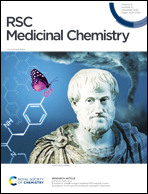Newly synthesized 6-substituted piperazine/phenyl-9-cyclopentyl containing purine nucleobase analogs act as potent anticancer agents and induce apoptosis via inhibiting Src in hepatocellular carcinoma cells†
Abstract
Newly synthesized 6-substituted piperazine/phenyl-9-cyclopentyl-containing purine nucleobase analogs were tested for their in vitro anticancer activity against human cancer cells. Compounds 15, 17–24, 49, and 56 with IC50 values less than 10 μM were selected for further examination on an enlarged panel of liver cancer cell lines. Experiments revealed that compound 19 utilizes its high cytotoxic potential (IC50 < 5 μM) to induce apoptosis in vitro. Compound 19 displayed a KINOMEscan selectivity score S35 of 0.02 and S10 of 0.01 and demonstrated a significant selectivity against anaplastic lymphoma kinase (ALK) and Bruton's tyrosine kinase (BTK) over other kinases. Compounds 19, 21, 22, 23, and 56 complexed with ALK, BTK, and (discoidin domain-containing receptor 2) DDR2 were analyzed structurally for binding site interactions and binding affinities via molecular docking and molecular dynamics simulations. Compounds 19 and 56 displayed similar interactions with the activation loop of the kinases, while only compound 19 reached toward the multiple subsites of the active site. Cell cycle and signaling pathway analyses exhibited that compound 19 decreases phosho-Src, phospho-Rb, cyclin E, and cdk2 levels in liver cancer cells, eventually inducing apoptosis.

- This article is part of the themed collection: World Cancer Day 2024: Showcasing cancer research across the RSC


 Please wait while we load your content...
Please wait while we load your content...